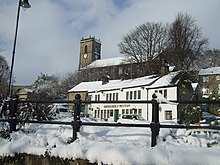Slaithwaite
Between 1195 and 1205, Roger de Laci, Constable of Chester, gave the manor of Slaithwaite to Henry Teutonicus (Lord Tyas).It eventually joined the estates of the Earl of Dartmouth, a descendant of the Kayes, and was part of the upper division of the wapentake of Agbrigg.In the 1848 edition of A Topographical Dictionary of England, Samuel Lewis (the editor) wrote: "the lands are in meadow and pasture, with a small portion of arable; the scenery is bold and romantic.The town is beautifully seated in the valley of the river Colne; the inhabitants are mostly employed in the woollen manufacture, in the spinning of cotton and silk, and in silk-weaving"[4] Slaithwaite Hall, (dated by dendrochronology to 1452), is located on a nearby hillside.[5] Legend has it that local smugglers caught by the excise men tried to explain their nocturnal activities as 'raking the moon from the canal' and definitely not as 'fishing out smuggled brandy'.[7] Slaithwaite Town Hall in Lewisham Road served as the municipal headquarters of successive local authorities in the area until the abolition of Colne Valley Urban District Council in 1974.[16] There are several traditional public houses in Slaithwaite, including the 'Silent Woman' which came to the attention of the world media on 23 September 2007, when Christopher Hawkins walked into the pub and ordered a pint of beer a few minutes after he had murdered his son and attacked his daughter with a knife.The Colne Valley defines local geography by channelling the railway line, the canal and the A62: each of which has at one time been the primary means of transport across the Pennines.



West YorkshireOS grid referenceLondonMetropolitan boroughKirkleesMetropolitan countyRegionYorkshire and the HumberCountryEnglandSovereign statePost townPostcode districtDialling codePoliceAmbulanceYorkshireUK ParliamentColne ValleyOld NorsethwaiteHistoricallyWest Riding of YorkshireHuddersfield Narrow CanalHuddersfieldSlaithwaite Town HallEarl of DartmouthwapentakeAgbriggtownshipsulphurousHarrogateschoolcottagesLegendsmugglersexcise mennocturnalbrandyGolcarMarsdenLinthwaiteWiltshirechapelryexcavationlock gatesrailwayThornton & RossAnglicanpublic housesManchesterSlaithwaite railway stationPennineshumpback bridgenarrowboatsFirst West YorkshireFirst ManchesterOldhamHolmfirthHuddersfield Narrow Canal TowpathBBC YorkshireITV YorkshireEmley MoorBBC Radio LeedsHeart YorkshireCapital YorkshireHits Radio West YorkshireGreatest Hits Radio West YorkshireHuddersfield Daily ExaminerWilliam CrowtherAucklandHaydn WoodListed buildings in Colne Valley (central area)English Place-Name SocietyWayback MachineA Vision of Britain through TimeCeremonial countyCity of BradfordCity of LeedsCity of WakefieldMetropolitan Borough of CalderdaleMetropolitan Borough of KirkleesBaildonBatleyBingleyBirstallBradfordBrighouseCastlefordClaytonCleckheatonDenholmeDewsburyEllandFarsleyFeatherstoneGarforthGomersalGreetlandGuiseleyHalifaxHaworthHebden BridgeHeckmondwikeHemsworthHipperholme and LightcliffeHorburyHorsforthIlkleyKeighleyKippaxKirkburtonKnottingleyLiversedgeMelthamMirfieldMorleyNormantonOssettPontefractPudseyQueensburyRothwellShipleySilsdenSouth Elmsall